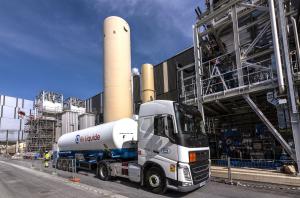Fill it up, please!
A white, vapour-like plume escapes from a valve on top of the cryoplant's liquid nitrogen storage tank. Like the smoke coming out of a cardinals' conclave, it delivers an important message: the first cryogenic system in the ITER installation has entered the commissioning phase.
The fill-up began last week as liquid nitrogen was pumped out of a succession of Air Liquide trucks into the cryoplant's giant 300-cubic-metre, 20-metre-tall vertical tank. During the commissioning phase, the tank will be 80% filled to verify the rate of evaporation, which should not exceed 0.16 percent of the total volume per day.
Liquid nitrogen (LN2) has multiple applications in the ITER installation, both at the commissioning and operational phases. Once ITER enters operation, LN2 will be used to cool down gaseous helium in the 80 K loop's heat exchangers before it is sent to the tokamak's thermal shields; it will also be used to "pre-cool" gaseous helium in the liquid helium cold boxes. LN2 will also be needed to initiate the distillation process that separates nitrogen from ambient air, to trap impurities in the gaseous helium purification systems, and again as a cooler to maintain gaseous helium temperature between minus 173 °C and minus 193 °C in the helium storage and quench tanks.
During pre-commissioning, gaseous nitrogen is essentially used as a "drier" for the absorber beds in the cold boxes, the charcoal elements in the recovery and purification system, and the liquid helium compressors' oil removal system.
Whether in gaseous or liquid form, nitrogen will be in strong demand at ITER. By chance, it is also quite abundant as it accounts for 78 percent of the air we breathe. Once the distillation-from-air process is initiated in the on-site gaseous nitrogen generator, the system's production capacity will reach approximately 50 tonnes per day.



